Saturdays, noon to 1 p.m. ET on WICR 88.7 FM.
Or listen live from anywhere on WICR Online!
Our call-in number during the show: (317) 788-3314
.
May 19, 2018
Famous but forgotten: Indiana writer George Ade
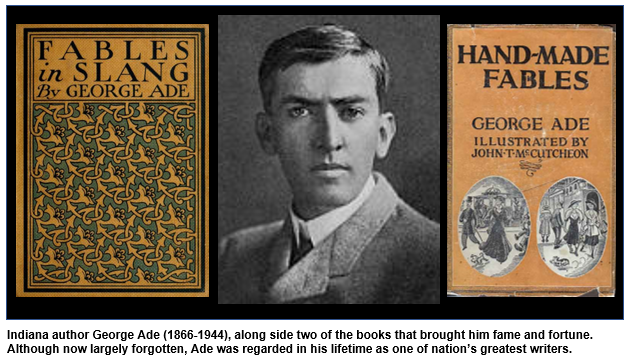
He may be the most famous Hoosier author you've never heard of.
In 1915 an Oxford literary scholar deemed him "the greatest living American writer." His work was regarded as part of a Golden Age of Indiana Literature, on par with the writing of such luminaries as Booth Tarkington and Theodore Dreiser. His earnings as a writer financed the construction of a lavish English Tudor estate near the banks of the Iroquois River in Newton County, where he hosted parties for Presidents and celebrities. By the 1920s he had accumulated enough wealth that he could help fund the construction of a football stadium at his alma mater.
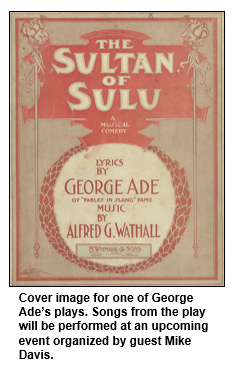
But an enterprising resident of Newton County in northwest Indiana hopes to change all that.
Hoosier History Live associate producer and guest host Mick Armbruster will be joined in studio by Mike Davis to explore the life, humor and literary legacy of George Ade. Mike has portrayed Ade in historical reenactments and is organizing an upcoming musical show dedicated to Ade's creative work as a song lyricist. Mick will also welcome Jeannie Logan of Indianapolis, who will star as vocalist in that show featuring Ade's songs. Pianist David Meek, also of Indianapolis, will provide accompaniment and additional vocals for the musical performance and will also join Mick and his guests in discussing Ade's place in Hoosier cultural history.
In many ways, Ade's life reflects essential elements of the American experience at the turn of the 19th and 20th centuries. Born to an immigrant father and second-generation mother and raised on a farm near the small town of Kentland, Ind, Ade showed early academic promise and attended Purdue University on scholarship.
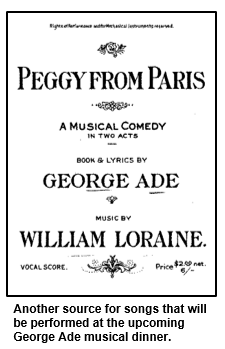
Like many young people of the era who had grown up in rural America, Ade chose to relocate the big city to begin his career. Within a few years of graduating from Purdue, Ade took up residence in Chicago and found work reporting the weather for a daily paper. His colorful sketches of how the weather impacted the lives of everyday citizens made such an impression that he quickly was granted a humor column, "Stories of the Streets and of the Town." The newspaper sketches and "fables" of ordinary city folk - which Mike notes reveal Ade's remarkable powers of observation - later served as the basis for several best-selling books.
Later in his career, Ade applied his satirical take on life to writing works for musical theater; at one point he had three theatrical works playing on Broadway simultaneously. Guest Jeannie Logan describes Ade's lyrics as "sophisticated and witty" and compares them to the sly humor of Noel Coward.
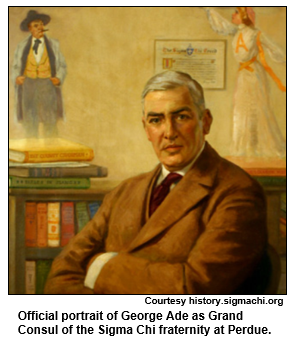
Ade's talents as a lyricist will be heard in their original musical context in an upcoming dinner theater project Mike is organizing with Jeannie and David. The meal will recreate the chicken dinner George Ade was famous for serving guests, as well as feature renditions of music from two of his plays, The Sultan of Sulu and Peggy from Paris. There will be two performances, June 3, and June 10, 2018 at the Old Colonial Inn in Kentland.
What unique insights about life do Ade's writings offer us today? Does his humor hold up for a contemporary audience?
Join us in exploring the range of George Ade's creative work as we talk with guests Mike, Jeannie and David about their efforts to breath new life into this Hoosier writer's literary legacy.
Roadtrip: Hazelden, the home of George Ade
Guest Roadtripper Tim Myer invites us to Brook, Ind. in the northeast corner of the state to visit the elegant home of George Ade.
Ade built the English Tudor-style estate in 1904 as a retreat from his hectic schedule in Chicago, where he lived at the time. Ade originally intended to build a simple cabin, but once he hired Chicago architect Billy Manns, the project grew enormously in scope.
By the time construction was complete, the project had become a two-story, grand Elizabethan manor home surrounded by landscaped gardens, pool, pool house, garage, greenhouse, barns, outbuildings and a caretaker's home. A passionate golfer, Ade added a golf course and country club in 1910. He named the estate Hazelden in honor of his English maternal grandparents.
Ade's home quickly became the social center of the area and hosted visits from four U.S. presidents, as well as some of the nation's most celebrated personalities of the time.
Of the many notable parties and events held at Hazelden, Tim our draws our attention to one of the most famous: a political rally in 1908, in which William Howard Taft kicked off his run for the presidency. Historical accounts estimate the crowd in attendance to be over 25,000.
Hazelden may be toured by appointment only; please call the Newton County Historical Society at 219-474-6944 to schedule a visit.
History Mystery
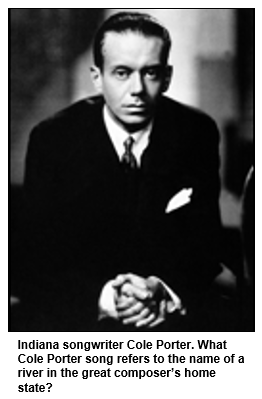
One notable exception: a song in which Porter refers to a river in Indiana - in fact, the river's name is in the title of the song. We won't reveal the 1943 show that the song comes from, but we will note that the song was performed by Ethel Merman, starring in her fifth Porter musical.
Question: What is the name of the Cole Porter song which refers to a river in Indiana?
Hint: It's not "On the Banks of the Wabash, Far Away" which was written by Paul Dresser and adopted as the Indiana state song in 1913.
The call-in number is (317) 788-3314. Please do not call in to the show until you hear Nelson pose the question on the air, and please do not try to win if you have won any other prize on WICR during the last two months. You must be willing to give your first name to our engineer, you must answer the question correctly on the air and you must be willing to give your mailing address to our engineer so we can mail the prize pack to you. The prize is two passes to the Story Inn in Brown County, courtesy of the Story Inn, and two passes to the Indiana History Center, courtesy of the Indiana Historical Society.
Joining Nelson in studio last week...

Nelson Price, host and historian
Molly Head, producer/project manager, (317) 927-9101
Michael Armbruster, associate producer
Cheryl Lamb, marketing and administrative manager
Richard Sullivan, senior tech consultant
Pam Fraizer, graphic designer
Garry Chilluffo, special events consultant
Please tell our sponsors that you appreciate their support!

 Acknowledgments to Monomedia, Visit Indy, WICR-FM, Fraizer Designs, Heritage Photo & Research Services, Henri Pensis, Chris Shoulders and many other individuals and organizations. We are an independently produced program and are self-supporting through organizational sponsorships and individual contributions. We do not receive any government funding. Visit our website to learn how you can support us financially. Also, see our Twitter feed and our Facebook page for regular updates. And thanks to the Indiana University Bicentennial for sponsoring the podcast of the "Faculty war of 1832: Early IU history" show. Any of our podcasts can be sponsored for a nominal fee.
Acknowledgments to Monomedia, Visit Indy, WICR-FM, Fraizer Designs, Heritage Photo & Research Services, Henri Pensis, Chris Shoulders and many other individuals and organizations. We are an independently produced program and are self-supporting through organizational sponsorships and individual contributions. We do not receive any government funding. Visit our website to learn how you can support us financially. Also, see our Twitter feed and our Facebook page for regular updates. And thanks to the Indiana University Bicentennial for sponsoring the podcast of the "Faculty war of 1832: Early IU history" show. Any of our podcasts can be sponsored for a nominal fee.
Thank you!
We'd like to thank the following recent, new and renewal contributors whose donations help make this show possible!
- Daniel Craig
- In memory of Elizabeth Meyer Strain Gunn by Roz Wolen
- Margaret Smith
- Stacia Gorge
- Robin Jarrett
May 26 2018 - Upcoming
International aspects of early Indy 500s

In 2017, the Indianapolis 500 was won by a driver born in Japan. Over the last 15 years, victorious drivers in the "Greatest Spectacle in Racing" have included natives of Colombia, Brazil, Scotland, England and New Zealand.
So while race fans are probably well aware of the prominence of foreign drivers in recent years, they may not know that the impact of international racers was nearly as significant during the early era of the Indianapolis Motor Speedway, beginning just a few years after the inaugural Indy 500 in 1911.
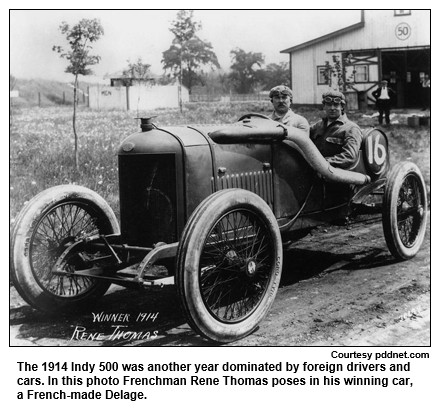
In 1913, the Indy 500 was won by a Frenchman driving a car made in his homeland. Other European entries that year included competitors from England and Italy.
Another driver from France won the Indy 500 in 1914. The next year, an Italian sped to Victory Lane. Then came the fabled Chevrolet Brothers, who had lived in France and Switzerland. Two of the three Chevrolet brothers, who died nearly penniless, are buried in the Holy Cross and St. Joseph Cemetery on the eastside of Indy.
Indianapolis native Mark Dill, an auto racing historian and marketer now based in Cary, N.C., will be Nelson's studio guest to describe the international drivers and overseas automakers who competed in early Indy 500s. Mark has written an article about the history of early drivers for the racetrack program that will be distributed at this year's Indy 500; he oversees an extensively researched and illustrated website about auto racing history.
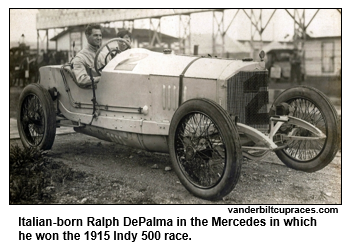
"Legend has it that Goux consumed six pints of Champagne during pit stops," Mark says, "but the reality is probably a different story. Goux competed in five Indianapolis 500s, finishing first, fourth and third in his first three efforts."
Three of his competitors in the 1913 race drove Isottas manufactured in Italy. "The Isottas traveled across the Atlantic Ocean aboard the Lusitania and arrived just three days before the race," Mark explains. (Two years later the Lusitania, a British ocean liner, was torpedoed by Germans during World War I.)
Of the Indy 500 in 1914, Mark says: "The French dominated, finishing in the top four places." The triumphant drivers included winner Rene Thomas, who drove a Delage made in France.
The next year, the winner at the Speedway was Ralph DePalma, who had been born in Italy.
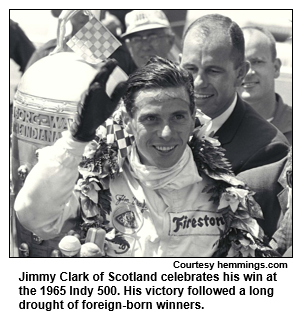
This was the era of the three Chevrolet brothers: Louis, Arthur and Gaston, founders of the Chevrolet Motor Company. Although Louis is considered to have been the most successful driver among the three, youngest brother Gaston was the sibling who captured the checkered flag at the Speedway, winning the Indy 500 in 1920.
During our show, Mark will discuss the dramatic lives of the Chevrolet brothers. He also will explore some of the reasons for the long drought - following Gaston's win in 1920 - of foreign-born winners of the Indy 500. The drought lasted almost without interruption until the victory in 1965 by popular Jimmy Clark of Scotland.
Mark Dill was a guest on Hoosier History Live two years ago for a show that also focused on Indy 500 drivers, but looked at the opposite end of the spectrum of drivers' origins. That show highlighted Indiana natives who won - or became fan favorites - in early Indy 500s.
© 2018 Hoosier History Live. All rights reserved.
|






